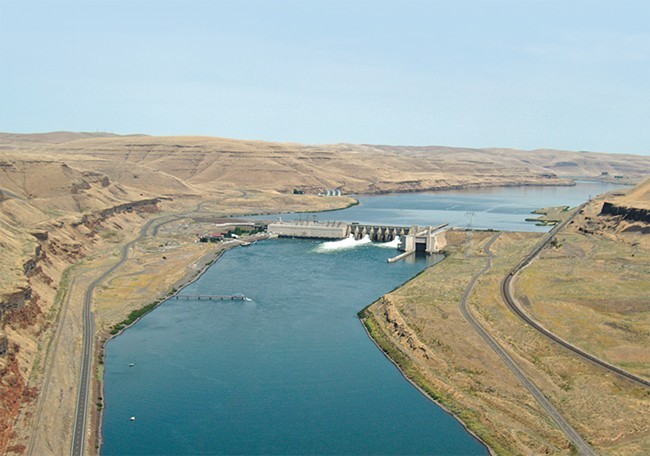forum
library
tutorial
contact

Dams and Fish are Possible
If We're Willing to Talk It Out
by Jeff Sayre
Lewiston Tribune, October 6, 2019
|
the film forum library tutorial contact |

|
Dams and Fish are Possible
by Jeff Sayre
|
 When I started fishing the Snake River for steelhead in September of 1984, it was a steep learning curve from the trout I fished for on the Spokane River and lakes around Cheney.
When I started fishing the Snake River for steelhead in September of 1984, it was a steep learning curve from the trout I fished for on the Spokane River and lakes around Cheney.
I eventually became a resident of Idaho and worked at fishing the Clearwater River. I did well for years, some nights hooking dozens. I also saw guys hook 30 or more in one night. That's all changed.
Hydroelectric direct current electricity started in 1880, the same year Thomas Edison invented the incandescent filament light bulb. Electricity changed America for the good of many. Hydroelectricity changed many desert and desolate Western states forever. They grew agricultural products to feed America. And population growth followed. President Franklin D. Roosevelt actually started the idea of building dams on the Columbia River at Bonneville Dam's location. He was a visionary in that sense and knew electricity would change the Pacific Northwest. He visited the shores of the Columbia in 1932, 1934 and again in September of 1937 for the dedication of the unfinished New Deal project.
At Bonneville Dam's dedication, FDR spoke words that, in part, ring true today:
"My friends of the Northwest, today I have a feeling of real satisfaction in witnessing the completion of another great national project, and a pleasure in the fact that, in its inception four years ago, I had some part. ... Almost exactly three years ago, I inspected the early construction stages of this dam at Bonneville. ... The more we study the water resources of the nation, the more we accept the fact that their use is a matter of national concern."We are now almost 30 years into federal court battles over the management of the Columbia and Snake rivers, both of national concern. Federal judges are making decisions over the "right" management of the river systems. None of them is a dam operator.
This is probably the most complex natural resource issue in the Western U.S., if not the entire country. Environmental groups have teamed up to tie it all up repeatedly in the slow federal court system to force a decision that moves only in their direction.
They don't care about the rest of us -- the folks who love the working river system FDR started and we use today in so many ways.
Have mistakes been made from Bonneville Dam to Lower Granite Dam and beyond in dam designs? Yes. Engineers have tried to fix many of those issues as they moved upriver at each project.
Each dam has been retrofitted to make them more energy-efficient and to make them easier for salmonids to pass and return through. Millions of your electric bill dollars have been spent on habitat restoration. They do work. I've seen it work.
We can have both dams and fish.
There is clear evidence even before Bonneville Dam was built that commercial salmon harvests on the Columbia River were slaughtering returning salmon from Idaho, Oregon and Washington.
According to a Native Fish Society report on the decline of salmon in the Columbia basin, the Payette River in 1874 produced a commercial catch of 30,000 pounds of sockeye, about 7,000 fish. Did that have an impact on overall historic sockeye returns to Idaho? Yes. It was gone by 1880.
 In 1880, there were 39 canneries on the Columbia. In 1882 they harvested 42.8 million pounds of salmon, about 3 million salmon, producing 600,000 cases of canned salmon.
In 1880, there were 39 canneries on the Columbia. In 1882 they harvested 42.8 million pounds of salmon, about 3 million salmon, producing 600,000 cases of canned salmon.
In 1883, the commercial fishery on the Columbia peaked and there were 1,700 gill net boats fishing.
By 1889, only 18.3 million pounds were taken. The population had been hammered in six years.
Also in 1889, there were 57 fish wheels operating upstream 30 miles from Bonneville almost to Celilo Falls. The best fish wheels took about 6,000 fish a day.
The fish were hammered.
When the chinook were gone, they went on to sockeye and steelhead. When those were gone, they moved to coho and chums.
The fish were hammered more.
When those five species were diminished, they moved to fall chinook. Did that influence historic salmon runs to the Snake and Columbia headwaters today? Yes, absolutely.
Unfortunately, salmon are one of those casualties of the modern world. Why? Poor planning for progress and money? Development of the West and the imperative to feed people?
Many state fisheries and indigenous tribes screamed of the demise of these powerful fish in the late 1890s but their pleas fell on deaf ears.
Can we turn back time and fix it? Should we keep or remove the dams? Should we destroy the entire Pacific Northwest's combined economies? What about all the people? We all live here.
Whatever happens does absolutely affect all of us.
Here is an idea: Call on Oregon, Washington and Idaho college and university students and departments to help us solve this matter. Come up with new ideas, new plans, new conversations, new collaborations and new technologies.
We can solve this together. We must all talk it out.
Related Pages:
Puget Sound's Orcas are Dying from Pollution, Not Dams by Jeff Sayre, Lewiston Tribune, 2/3/19
learn more on topics covered in the film
see the video
read the script
learn the songs
discussion forum
